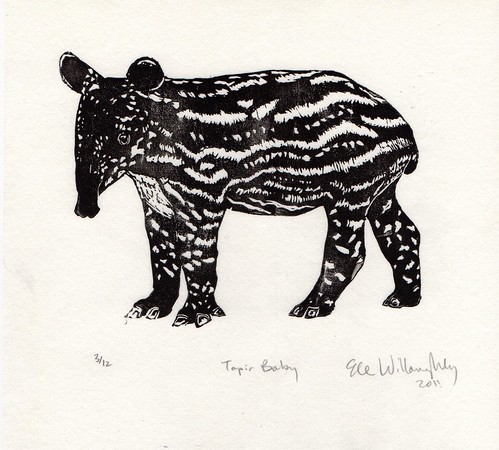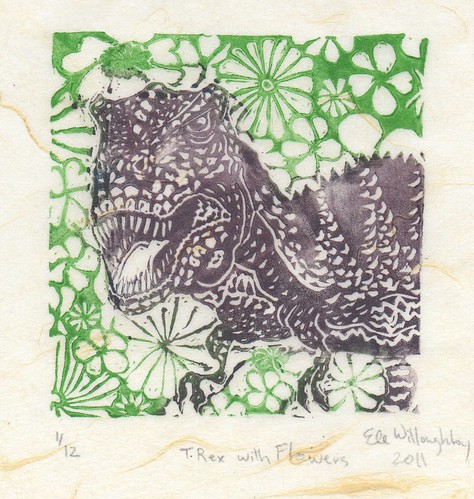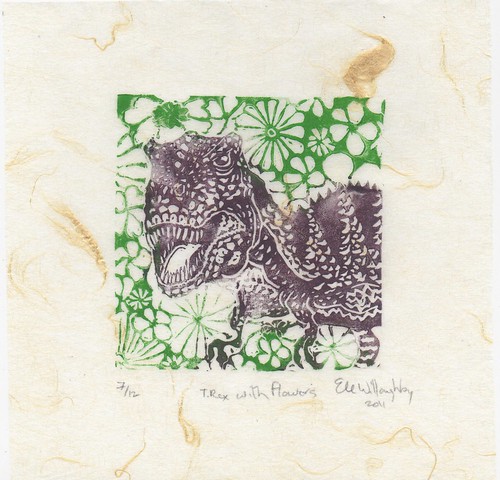


So we did make it to Nuit Blanche, but though I read everything I could, we didn't have a thorough plan or make it out the door very efficiently. We did however manage to see a lot of interesting things, sometimes through sheer serendipity. We started out on the U of T campus trying to find a place to park, when we passed the International Student Centre - which wasn't on my list - but we were drawn in by the pink cords and suspended labels wrapped in a web around all their trees.
Maleta Stories was one event with, to my mind, superceded its description. The installation was about immigration, particularly people who came to Canada with one suitcase from the Philipines. By inviting participation from attendees, who could fill in tags and attach them to the wires through the trees, it really became much more universal and fascinating. We wandered under the wires reading people's stories. I imagine the installation would have grown more layered and interesting through the night.
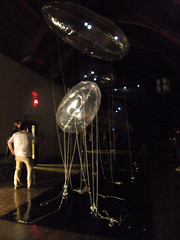

Next we headed to Hart House, passing various installations involving lights and music, and apparently video games, along the way. I wanted to see
AirSHIP. The Music Room, with its pseudo-medieval vaulted wooden ceiling was a wonderful venue for these luminous blimps. They proved very difficult to photograph, but imagine the ceiling filled with transparent blimps with globes of interior light, trailing strings to a mirrored floor, with ambient music. I heard someone compare them to giant jellyfish. It had a sort of magic. Also impressive was that this art installation was made by engineering and architecture students who are part of a solar blimp team.

Next we headed over to Victoria College (technically University, but whatever, I say, as an alumni).
 Slow Moving Falls
Slow Moving Falls was projected on a two and half storey screen in front of the building. It shows a film of Niagara Falls, projected upsidedown and in extreme slow motion. It was mesmerizing. It was funny to see people try tp bend over and look at the screen with their heads upsidedown. Around the corner was
Radiophonic Territory which involved an exterior "confessional" where confessions were broadcast within the building and on the radio. Since this installation wasn't on my priority list, we didn't stand in line to hear the confessions, but we watched people consider entering the box.
I was anxious to see and participate in
L'écho-L'eau, a simulated log-run within the MaRS building. Despite the long line on the exterior of the building, the wait wasn't too long - in fact we spent far less time in lines this year. We even had to sign a waiver, but that didn't slow us down. There was an immense but shallow pool set up in the large lobby. We had to remove out shoes and walk through the water. At the far end was the 'log-run'. We were given large umbrellas and got to walk on the logs under similated rain. I enjoyed the experience. After the log run we were encouraged to look at the 'reflecting pool' with illusion on the floor below. (On our way we passed
Taddle Creek sound installation at University and College - which, while not substantial, was evocative of the sound of a river).







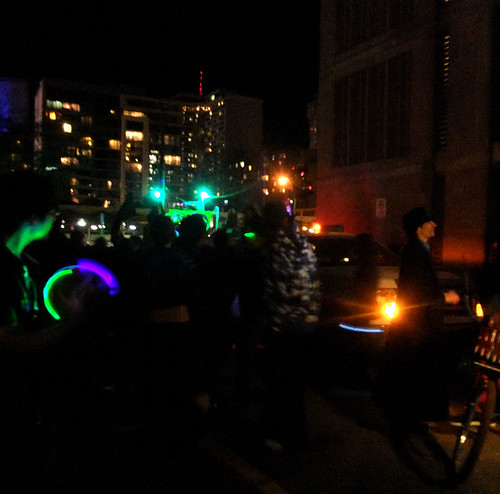

I wanted to see
The Heart Machine, a flame-throwing installation from Burning Man. We went down University Ave. and were confused by one of the nomadic installation, which I heard called the 'Renegade Parade', though I haven't found it on the website. The travelling installation was a rave on wheels; a pickup truck with DJ, dancers and light show which was advancing through the streets. When we reached the Heart Machine, so did the rave. RJH wanted to photograph the rave, but I wove through the cars to the flames, and found myself behind the Heart Machine. Though cordoned off, we had a better view than the crowd at the front. Soon, using his trusty business card (not even a press pass) RJH talked himself up onto the scaffholding to photograph the scene from above. The woman at the cordon allowed me in and said I could stay out of the way by the truck. Much to my amusement, while RJH photographed the scene, Nuit Blanche volunteers assumed I was on staff and started reporting to me. I was told that the Renegade Parade performers were going to come through. I asked if I was in the way and was told, "Oh no, I just thought you should know," so I played along and granted my approval. It was quite the spectacle with flames on one side and rave on the other.



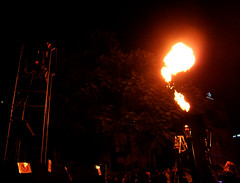






Next we headed downtown. I wanted to see installation at the Eaton Centre and City Hall. We parked and headed through the crowd. Fist we hit
Barricades, a sort of commentary on the G20 and surrounding events in this city, which turned barricades on their heads.



Then we made it into the Eaton Centre and found the
Paparazzi Bots. Moving robots, equipped with point-and-shoot cameras and facial recognition software could choose (or not choose) people to focus on like paparazzi, to photograph and broadcast their image. It was interesting to see people grinning hopefully, wanting to be the centre of attention.



We headed past
Shannon's Fireflies, which unfortunately was having technical difficulties, and thus was not lit, to City Hall. He heard the eery invisible parade (music broadcast without visible source). I was interested to see people 'flying' around Nathan Phillips Square. I knew lines would be long, but thought they would be something to see. It turns out that the lightshow was much more interesting.
Flight Path allowed visitors to ride a bird-shaped zip-line container to 'fly' across the square - except they moved quite slowly, so it wasn't that exciting. The lightshow, on the other hand was very impressive. Lines and planes of multicolour light were visible throughout the smokey square. It seemed that images of clouds were projected onto the light planes. This gave the illusion of a 3D projection, and the feeling of being embedded in the sky. The lights also formed archways, squiggles and other shaped.

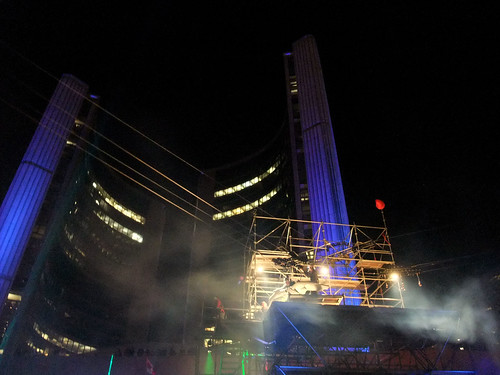






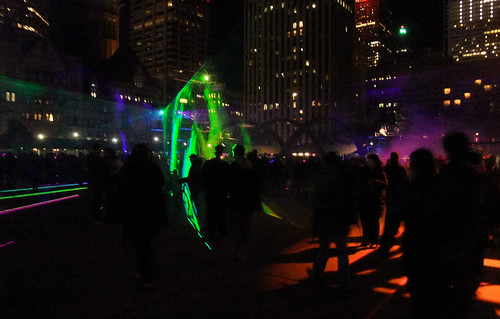

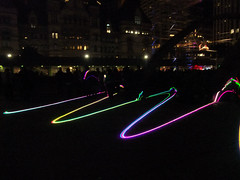


To the south of City Hall, someone played drums within a disassembled car, which exploded outward as in an 'exploded technical diagram'.

I needed to see the glowing wolves, so we headed to the Cloud Garden, north of Scotia Plaza to see
INFRA. To be honest, I was expecting more from the resin wolves glowing with fluorescent colours allegedly micmicking their heat energy as viewed in the infrared.

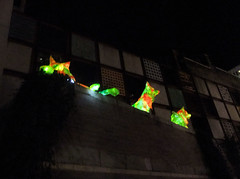


Inside the Scotia Plaza, I was keen to see
City Mouse, a sculptural investigation of what is natural. Within the skyscrapper's lobby, a miniature simulated forest is filled with taxidermied animals (raccoon, wolf, bear and hawk). The animals in turn are filled with unusual and detailed scenes of masked business people, at their desks, in their cubicles, waiting for the elevator or shredding documents. I was not disappointed, despite the wait to see a small exhibit; I really admire what worlds artist Julia Hepburn created.





We headed home after that, quite slowly. We debated going to Trinity-Bellwoods, but only drove by. I wanted to see the balloon installation outside the Drake Hotel. It was a mistake to attempt to drive along Queen Street just as the bars let out, but I did catch a glimpse of the giant clown, the patchwork covered van, and other Parkdale LEITMOTIF entries.

Overall, it was a good night. I felt perhaps less moved than on other previous Nuits Blanches, but, we managed to see some intriging and beguiling art, some great spectacle, no one fell off a dubious scaffholding, and we had some unusual experiences we won't soon forget. This is really a wonderful event in the life of the city, and everyone should check out what they can.



